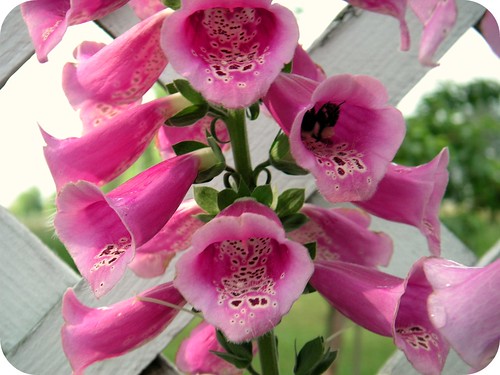"Gaia's Garden-A Guide to Home-scale Permaculture" has been one of the more interesting reads I had on my list of not so typical vacation reading. Just a side note before I get into just how much I enjoyed this book, Gaia is a name for Mother Earth or Diana if you weren't aware. The author does present a "what-can-we -learn-from-mother-earth" type perspective in the book, which if it were presented in more of a what-can-we-learn-from-God's-design would be spot on-I'm just going to have to find more places in my daily life to say spot on, jolly good ya'know. Most of the book focuses on practial hands on information. I'm not done with the book yet, but besides the twinges of mother earth stuff I would highly recommended it. The idea of permaculture is to not simply make your land (however big or small) lovely but to make your yard and garden useful, to place plants and structures into relationships with each other which are mutually beneficial. The phrase permaculture comes from the words permanent and culture. I think one of the easiest examples of it I have heard goes something like this. You have a fenced in area for chickens, which is located in full sun. So you build a small arbor over the area and grow a vining plant over it to gi ve shade. You want grapes so you choose to plant them here, because grape vines attract Japanese Beetles, which love to eat your grapes, but chickens also love to eat Japanese Beetles. So you spend less money on chicken feed, have better grapes, and free on sight fertilization, and you get it all with less chemicals, and minimum effort except lots of forethought. Implementing permaculter ideas into your yard isn't simply a step by step list. You have to think about how you eat, what you like, what you have and what you want, and then step back and look at all these pieces and see how they can fit together in the most useful ways. This is a HUGH creative challenge. Part of the pay off for taking the time to plan all this is that your yard is more sustainable, requiring less effort and higher pay-offs. Who mows and fertilizes and mulches the forest? And yet these things happen in nature, why not in your own yard? This books really gives you tools to make this happen and think about all the possibilities. If you're at all interested in doing something to your yard either now or in the future I recommend you pick up a copy of this. Even though I borrowed this from the library I can tell it's a book I will want my own copy of to refer back to again and again, and hopefully in the future I'll be able to post about putting some of these ideas into practice. You can preview the book here for yourself. Note- I was reading the first addition, but I'm sure the second addition is just as good.
ve shade. You want grapes so you choose to plant them here, because grape vines attract Japanese Beetles, which love to eat your grapes, but chickens also love to eat Japanese Beetles. So you spend less money on chicken feed, have better grapes, and free on sight fertilization, and you get it all with less chemicals, and minimum effort except lots of forethought. Implementing permaculter ideas into your yard isn't simply a step by step list. You have to think about how you eat, what you like, what you have and what you want, and then step back and look at all these pieces and see how they can fit together in the most useful ways. This is a HUGH creative challenge. Part of the pay off for taking the time to plan all this is that your yard is more sustainable, requiring less effort and higher pay-offs. Who mows and fertilizes and mulches the forest? And yet these things happen in nature, why not in your own yard? This books really gives you tools to make this happen and think about all the possibilities. If you're at all interested in doing something to your yard either now or in the future I recommend you pick up a copy of this. Even though I borrowed this from the library I can tell it's a book I will want my own copy of to refer back to again and again, and hopefully in the future I'll be able to post about putting some of these ideas into practice. You can preview the book here for yourself. Note- I was reading the first addition, but I'm sure the second addition is just as good.
 ve shade. You want grapes so you choose to plant them here, because grape vines attract Japanese Beetles, which love to eat your grapes, but chickens also love to eat Japanese Beetles. So you spend less money on chicken feed, have better grapes, and free on sight fertilization, and you get it all with less chemicals, and minimum effort except lots of forethought. Implementing permaculter ideas into your yard isn't simply a step by step list. You have to think about how you eat, what you like, what you have and what you want, and then step back and look at all these pieces and see how they can fit together in the most useful ways. This is a HUGH creative challenge. Part of the pay off for taking the time to plan all this is that your yard is more sustainable, requiring less effort and higher pay-offs. Who mows and fertilizes and mulches the forest? And yet these things happen in nature, why not in your own yard? This books really gives you tools to make this happen and think about all the possibilities. If you're at all interested in doing something to your yard either now or in the future I recommend you pick up a copy of this. Even though I borrowed this from the library I can tell it's a book I will want my own copy of to refer back to again and again, and hopefully in the future I'll be able to post about putting some of these ideas into practice. You can preview the book here for yourself. Note- I was reading the first addition, but I'm sure the second addition is just as good.
ve shade. You want grapes so you choose to plant them here, because grape vines attract Japanese Beetles, which love to eat your grapes, but chickens also love to eat Japanese Beetles. So you spend less money on chicken feed, have better grapes, and free on sight fertilization, and you get it all with less chemicals, and minimum effort except lots of forethought. Implementing permaculter ideas into your yard isn't simply a step by step list. You have to think about how you eat, what you like, what you have and what you want, and then step back and look at all these pieces and see how they can fit together in the most useful ways. This is a HUGH creative challenge. Part of the pay off for taking the time to plan all this is that your yard is more sustainable, requiring less effort and higher pay-offs. Who mows and fertilizes and mulches the forest? And yet these things happen in nature, why not in your own yard? This books really gives you tools to make this happen and think about all the possibilities. If you're at all interested in doing something to your yard either now or in the future I recommend you pick up a copy of this. Even though I borrowed this from the library I can tell it's a book I will want my own copy of to refer back to again and again, and hopefully in the future I'll be able to post about putting some of these ideas into practice. You can preview the book here for yourself. Note- I was reading the first addition, but I'm sure the second addition is just as good.











Looks interesting.
ReplyDeleteFrom THE OMNIVORE'S DILLEMMA: Joel Saladin feeds his cows grass; he takes cows out of a pasture leaving cow patties; He lets the patties sit for three lays and flies lay eggs (flies pester cows and spread disease); then he brings in chickens while the flies are still larvae (and thus a) have not hatched into bothersome flies and b) make a rich tasety meal for chickens) the chicken eat the larvae and spread the manure; the manue makes the grass grow; the cows come back and eat more grass ......
Here's a simple one: My garden produces vegetables and some waste and weeds; I feed the waste adn weeds to the chickens; the chickens make eggs and compost the waste; I eat the eggs and use the compost to grow more vegetables.
BTW, I'm feeding 10 chickens on my 1/4 acre lot without having to buy feed--so far anyway.
Is this book pretty in-depth or more like something to get you thinking? I've been reading a lot over the last year about sustainable growing methods and ideas, DIY etc. When it comes time to put it all into practice, I find all of my "complete guides" have a lot of steps missing. As time permits, I'm hoping to write some "how to's" that are more like a recipe: List the things you need, lay things out step by step, and list the pitfalls. Yada Yada, permaculture has to be tailored to your area/needs, so maybe this comment would not apply to a permaculture book.
Yes I would say the book in depth. I'm going through it again as I breastfeed, a little each day, and it has given me much food for thought. It does not have specific projects laid out in it or a step by step guide, since each project would be so dependent on the resources available, but rather gives you all the tools you need to think critically about your own little corner of the world, come up with your own projects, and (I believe) successfully implement them. A glance at the table of contents on Amazon might give you a better idea of all the topics covered.
ReplyDelete